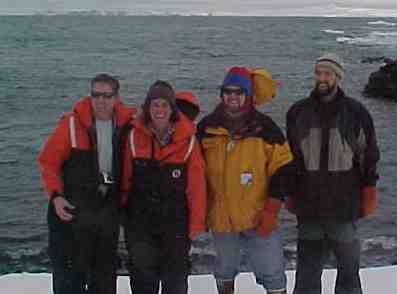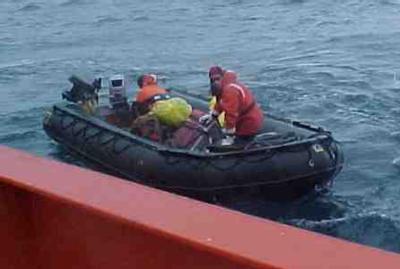16 November, 2000
Land Ho!
I woke up this morning to see something new out of my porthole. Land, okay
it was while land with a few rocks here and there. Still it didn't appear
to be moving up and down and from side to side. Therefore Terra Firma!
I was told that if the weather held up I would be allowed to go to ashore.
The weather was looking fantastic. Cape Shirreff, here I come. This wasn't
simply a tour but a working excursion. We were going to leave four
researchers along with equipment and supplies to last them for several
months. Mike Taft, from Oregon, and Iris Saxer, from Washington, would be
studying breeding habits of Gentoo and Chinstrap penguins. While Benjamin
Pister, from Alaska, and lead scientist Mike Goebel, from La Hoya, would be
studying seals.
The Gould was anchored in the water about two miles from the beach. We
would be off loading people and supplies into zodiacs. A zodiac is a six to
eight person boat with a hard floor. The crew would lower supplies into the
zodiac using a crane. Then passengers would climb down a ladder into the
zodiac and be whisked away. This would be my first step on the continent of
Antarctica. I was very excited. My mind was racing, what should I wear?
Fortunately my PI, Ray Smith, listed off the necessary items which included
a float coat. This coat must be worn while traveling on a zodiac from the
Gould. Not only does the float coat keep you warm but if you fall out of
the zodiac it will allow you to float. I didn't think it would be a good
idea to test the coat since the water temperature is 0.2 degrees Celsius.
I'll just assume that it works.
Cape Shirreff is an important research area. In the early 1800's seals were
hunted to extinction for their furs. Seals were not seen again in this area
until around 1965. At last years count, 1999-2000, there were about nine
thousand pups. Mike Goebel, the lead scientist, said that they will again
conduct a census, monitor foraging, population growth, and look at the
survival and pregnancy rates. One interesting fact that he shared about
seals was how they determine their age. Trees have growth rings, so do
seals teeth. So they pull a tooth and count the rings. I'm just thankful I
have birthdays or I wouldn't have any teeth left.
Seals normally have one pup a year. they mature at age 4 and have been
known to live to about twenty years. They can dive up to 200 meters but
normally stay in the top thirty meters where they find their favorite food,
krill.
Anyway, back to the story. I climb into the zodiac and we are on our way.
From a distance I can see large objects dotting the landscape. when we get
close enough I can see there are seals everywhere staking out territory. We
land the zodiac on the rocky beach and unload the cargo. We must haul the
supplies up to the three cabins while we thread our way between the seals.
If you get to close the seals will challenge you for the territory by
chasing you. Most of the area is covered with snow, seals or a few
outcroppings of rock. I loaded a sled with supplies and began the trek to
the cabins. Most of the seals casually glanced at me as I passed by. I saw
three different kinds of seals, the fur seal, the Waddell seal and the
greater southern elephant seal. They all allowed me to pass. During my
second trip however, one male started to come after me. I made a loud
barking noise, yes a barking noise, and he stopped. A little embarrassing
but it did the trick. We spent about two hours on shore moving supplies and
equipment. I want to make it very clear. Science is HEAVY!
The winds had slowly picked up speed as the day wore on. So we had to
quickly depart Cape Shirreff and the four researchers. The waters were very
choppy, it was like a ride a Universal Studios, but our zodiac captain
brought us safely back to the Gould.
My nine year old daughter Jennifer wrote me the following poem and hid it
in with my belongings. I just found it today.
Dozily, Dozily,
Deep in your bed,
You sleep with the moon,
With me in your head.
All of the people on board this ship have families. It is a hardship for
everyone involved. Her poem reminded me of the extreme sacrifice made by
the people I have meet to make sense of our world. Thanks, just doesn't
seem to cover it.
C-ya tommorrow,
Don't miss Friday's action packed episode -- Deception Island
PS. Thank you Jenny for the wonderful poem. I love you!
-- Bill

Researchers staying on Cape Shirreff

Zodiac departing from ship
Contact the TEA in the field at
.
If you cannot connect through your browser, copy the
TEA's e-mail address in the "To:" line of
your favorite e-mail package.
|
